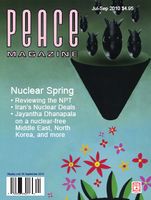
Peace Magazine Jul-Sep 2010, page 27. Some rights reserved.
Search for other articles by Adele#32;Buckley here
Understanding Sovereignty Disputes in the North. By Michael Byers (Vancouver: Douglas & McIntyre, 2009)
The climate-change-induced Arctic meltdown is transforming the Arctic on many fronts. Michael Byers systematically explores both historic and new security concerns. On sovereignty, Canada has no disputed land borders (with the possible exception of Hans Island) and the issue concerns the huge segment of the Arctic sea floor over which Canada will exercise sovereign rights. The exact limits are still to be determined under the United Nations Law of the Sea (UNCLOS); the north pole will certainly be part of the high seas. Sovereignty matters because of the rich natural resources on parts of the sea floor, the Arctic shipping lanes, fisheries, the necessity of protection of the fragile ecosystem and a variety of security needs.
Byers, an expert on international law, tells us that the waters of the Northwest Passage indisputably belong to Canada. However, the position of the US and others is that these are not internal waters. Instead, the claim is that it is an international waterway, allowing free and unannounced transit of foreign vessels. Providing Canada would be capable of exercising control, the preferred outcome would be a bilateral [US/Canada] agreement. In Byers’s view that would not destabilize other treaty regimes for other international waterways.
The book’s two appendices are about maritime issues; the first develops a scenario about an unannounced presence of a large container ship in the Northwest Passage. The second appendix relates the outcome of a Model Negotiation on Northern Waters that took place in early 2008 when two teams of non-governmental experts met to make recommendations to Canada and the US concerning all navigation-related interests in northern waters, such as environmental protection. The most significant of these is that the two countries should establish an Arctic Navigation Commission, including representation from indigenous groups. The new Commission would follow the successful model of the International Joint Commission that has operated well for 100 years.
In addition to the Northwest Passage, there are two other major themes regarding sovereignty—the land and the Inuit who occupy it, and the sea and sea-bed. The 1993 Nunavut Land Claim Agreement is cited several times, because the sovereignty claim of Canada is immeasurably strengthened by the fact that the Inuit have centuries of occupancy and use of the land, the sea, and the ice. A paragraph to this effect was introduced by Inuit negotiators. Despite the Harper government’s Northern Strategy to allocate resources and attention, such an effort is prone to mis-steps that offend the indigenous peoples—such as the failure to consult (the designated deep water ports are in locations that do not meet the needs of northern communities), or blundered apologies to the peoples who endured resettlement on inhospitable Resolute Bay.
Seabed claims are now being prepared by collecting additional data for compliance under UNCLOS. Byers enlightens us by relating the historical land and border settlements amongst nations, and understandings such as the sector theory, whereby national borders are extended in a straight line to the north pole. The sector principle, facing international opposition, is not applied, but is superseded by UNCLOS. Nevertheless Canadian diplomats saw benefits to Canada in keeping sector arguments alive. However, a 2006 Harper speech in Iqualuit effectively pronounced the demise of the sector theory. This could well have a negative influence in negotiations with the US over the resource-rich seabed of the Beaufort Sea.
A northern vision has been embedded in the national psyche of Canadians, but this book is not only for Canadians, but also for any global citizen who has a northern sensibility, even though he/she has never set foot there. Byers’s book is readable and very interesting, packed with information that all northern policy makers need. We can only hope that Prime Minister Harper and his advisers have read it too.
Reviewed by Adele Buckley, scientist, past Chair of Canadian Pugwash and member, Pugwash Council

Peace Magazine Jul-Sep 2010, page 27. Some rights reserved.
Search for other articles by Adele#32;Buckley here